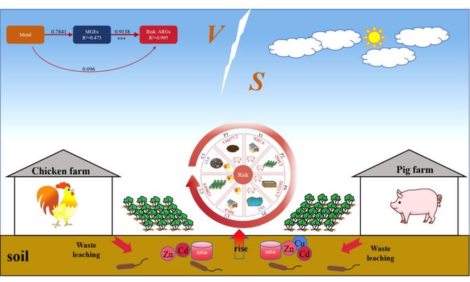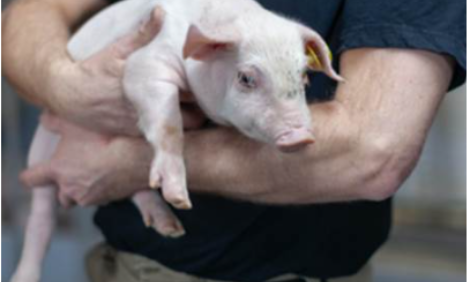



How Much Fusarium-Contaminated Grain Can I Feed My Pigs?
By Jim House, Department of Animal Science, University Of Manitoba - This article looks at the impacts of fusarium infection in feed in the swine industry. The report gives a brief background and strategies that have been pursued in dealing with the issue, then looks at the results of the University feeding trials to determine threshold levels for deoxynivalenol or DON in the diet.
 Jim House
Jim HouseDepartment of Animal Science University Of Manitoba |
In the post-Crow rate era, feeding locally produced cereal grains to pigs was seen as a way of boosting Manitoba's agricultural economy. The conversion of the energy and nutrients found in cereal grains into nutritious pork products creates a value-added product demanded by consumers both nationally and internationally. Over the last ten years, pig production in Manitoba has increased to over 6 million pigs, signifying that the proposed growth in the swine sector is occurring. However, at the same time that the swine industry has been expanding, the incidence of Fusarium head blight (FHB) has increased in Manitoba. This fungal disease creates a major challenge to both grain producers and swine producers.
In just the last ten years, FHB has established a stronghold in fields in Manitoba and the eastern prairie region of Canada, and the incidence is spreading westward. While the severity of an FHB outbreak will depend on the particular conditions of the growing season (ie: precipitation at time of flowering, temperature, cropping history, etc.), there is no question that the disease is here and here to stay. While FHB reduces grain yields and impacts quality, a concern for swine producers is the presence of toxic compounds produced by the fungi on the grain. These toxins, or myctoxins, can have negative effects when consumed by livestock. The primary mycotoxin found on cereal grains in Manitoba is deoxynivalenol, also known as DON or vomitoxin. This particular mycotoxin reduces feed intake in pigs, and therefore poses a serious threat to the sustainability of the swine sector in Manitoba and the eastern prairie region of Canada.
The mycotoxin DON was identified in the early 1970's to be the compound responsible for causing feed refusal and vomiting in swine. In fact, the observation that DON consumption caused swine to vomit led to the use of the term vomitoxin to describe this compound. However, vomiting is seldom reported in studies examining the impact of DON on swine performance and this term no longer routinely used. What is generally observed when swine are offered diets containing DON is some degree of feed refusal and concomitant reductions in performance. Based on data generated in the 1980's and early 1990's, producers can expect a 7.5% reduction in feed intake by swine for every 1 part per million (ppm) of DON found in the diet.
In 1990, the Canadian Food Inspection Agency recommended that swine diets should not contain DON at levels higher than 1 ppm, and further stated that diets for pregnant and lactating swine should be "DON-free". While this should be the goal for feed formulators, the feasibility of this approach will depend on a number of factors, chief amongst which is the availability of competitively priced, DON-free grains. Heavy Fusarium pressure over the last few years has made sourcing local DON-free grains difficult. For example, the DON content of barley grown at the University of Manitoba Glenlea Research Station was greater than 5 ppm for the 1999-2001 growing seasons. This severely restricts the utilization of this grain for on-farm mixing of swine diets, if CFIA guidelines are maintained. As a result, clean feed grains have been imported into Manitoba from Western Canada and the US, which has led to upward pressures on feed costs and an erosion of the competitive advantage that Manitoba has possessed relative to costs of production for pork.
In light of the high levels of Fusarium loads in Manitoba, strategies are needed for the effective management and utilization of DON-contaminated grains by the swine sector, in order to promote the sustainability of this industry. The primary method for dealing with DON-contaminated grains is dilution: Diluting contaminated grains with clean grains reduces the level of DON in the final feed. However, this requires the availability of "clean" grains, which may not be available locally. As a result, the feed industry has increased its reliance on imported grains from Alberta and Saskatchewan, as well as American corn, to meet the requirements for the swine industry.
Research to develop Fusarium-resistant varieties of wheat and barley are progressing. For several reasons, including registration challenges and the need to generate commercial quantities of seed, the introduction of these varieties into the marketplace is a minimum of 5 years away.
Other approaches to deal with the presence of DON in feed grains include the usage of dietary additives to reduce the toxicological effects of the mycotoxin. To date, most of these commercial products have been shown to be ineffective when subjected to third- party research testing.
At the University of Manitoba, we have been investigating the potential for pearling, or abrasive dehulling, to remove DON from contaminated barley. Our laboratory investigations have shown the by removing the hull fraction of barley (15% of the weight), we can remove roughly 70% of the DON. This technique shows promise, and we are in the process of scaling up the procedure and assessing the feeding value of the pearled barley for swine.
Another area that we have been addressing relates to the question of what is the highest level of DON that we can have in swine feeds before pig performance suffers. This is a critical question. While early research suggests that we should limit DON in swine feeds to less than 1 ppm, we must appreciate the fact that today's pigs and the management systems in use differ tremendously from what was being used twenty years ago. There is a need to reassess whether that 1 ppm threshold for DON is relevant. To this end, we conducted feeding trials with both grow-finisher pigs and starter pigs to determine threshold levels for DON in the diet.
In our first study, we examined the impact of feeding diets containing either 0, 1 or 2 parts per million (ppm) DON on the growth and performance of barrows and gilts, from 22 kg to market weight of 110 kg. The presence of DON in the diet at 2 ppm resulted in a 7.6% reduction in feed intake relative to the 0 ppm DON diet, with pigs consuming the 1 ppm diet having intermediate levels of feed refusal. Despite the reduction in feed intake, average daily gain was not affected (approx. 820 g/d).
Because the animals were not split sex fed, it was not possible to determine the impact of DON on feed intake for the sexes. However, we did find that gilts were more sensitive to the presence of DON than were barrows, as judged by the time required to reach market weight. The presence of DON in the diet at 1 and 2 ppm increased the median time required to reach market weight by 5.2 and 14.1 days, respectively, relative to the 0 ppm treatment. This delay in attaining market weight reduces opportunities for marketing large batches of gilts, and reduces the number of pigs that can be finished within a year. On the other hand, barrows were not affected by the presence of up to 2 ppm DON in the diet. This observation may signify an opportunity to use greater amounts of DON-contaminated barley in diets for barrows for those employing split-sex feeding programs.
An examination of the carcass data revealed that when pigs were marketed at the same weight, carcass weight, index, and backfat measurements were not affected by the presence of DON in the diet for either barrows or gilts. The only effects of DON that were observed were slightly higher loin premiums, due to greater loin depths, for both barrows ($2.34 vs. $1.77) and gilts ($2.63 vs. $1.90) consuming the 2 ppm DON diets versus the control diet. These results were unexpected and, to date, we have no explanation for these findings.
In a subsequent study, we examined the impact of going to 4 ppm DON in the diet on the performance of grow-finisher pigs. We observed that the presence of DON up to 4 ppm had no effect on feed intake, gain, feed efficiency, days required to reach 110 kg, or carcass measures for either barrows or gilts. The pigs took the same amount of time to reach market weight as observed in the first study, with barrows and gilts attaining 110 kg in a median time of 158.8 and 170.8 days, respectively. Therefore, unlike the previous study, gilts did not seem to be sensitive to the presence of DON in the diet.
The studies mentioned above provide evidence that grower-finisher pigs, and barrows in particular, have the ability to tolerate levels of DON higher than that recommended by the Canadian Food Inspection Agency. In order to address the issue of whether younger pigs may be sensitive to DON, a study was conducted with pigs weaned at 17 days of age. Pigs were separated by sex and allocated to receive starter diets containing either 0, 1 or 2 ppm DON. The trial lasted for 35 days, during which time data for feed intake, average daily gain, and feed efficiency were measured weekly. The presence of DON up to 2 ppm in the diet did not affect feed intake in either barrows or gilts, nor did it influence average daily gain or feed efficiency. Therefore, on the basis of our results, starter pigs of both sexes are able to tolerate DON levels up to 2 ppm, when the source of the DON is contaminated barley grown in Manitoba.
In summary of the feeding studies conducted to date, both starter and grower-finisher pigs of modern genotype are able to tolerate DON in the diet when present at levels above 1 ppm. Barrows appear able to tolerate levels of DON up to 4 ppm in the grower-finisher stage. Producers using split-sex feeding programs may be able to channel DON-contaminated grains to the feeding of male pigs. However, because we did observe some effects on females, care must be taken when formulating diets for gilts, and CFIA guidelines (maximum 1 ppm DON) should be adhered to.
DON creates variability, both within and between herds, and makes simple solutions for handling this mycotoxin difficult to obtain. Until we have a better understanding of the interplay between DON and factors such as environment, swine genetics, other mycotoxins, nutrition, and disease, our ability to predict how pigs will respond to a given level of DON in the diet will be limited. Our data provide evidence that pigs destined for market can tolerate higher levels of DON than recommended by CFIA. These results have tremendous implications for the feed industry in Manitoba - the higher the threshold level for DON, the greater amount of DON-contaminated grains that can be used. The establishment of new feeding guidelines, coupled with research on methods for reducing the DON-content of grains, may help promote the sustainability of the swine sector in Manitoba.
Source: University of Manitoba - Faculty of Agricultural and Food Sciences - June - 2003.








